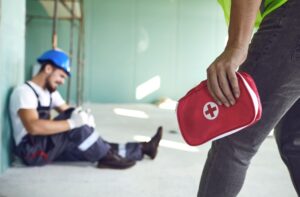A key aspect of managing a successful construction site is implementing robust health & safety measures and providing effective first-aid responses. These considerations are not merely regulatory requirements; they are critical to enabling a safe working environment, reducing the incidence of workplace injuries, and ensuring swift and appropriate response if accidents occur.
In this educational blog post, we delve into the core principles of health & safety in the construction industry and the indispensable role of first aid within this context. We’ll explore topics including why these practices are integral to the running of safe and efficient construction sites, how they can be implemented, and the benefits that come with comprehensive health & safety and first aid training for employees.
At CR Training, we understand the nuances of the construction industry and that the nature of the work can often bring about specific health & safety challenges. Our expertise lies in offering tailored training solutions that address these unique needs, fostering a culture of safety and preparedness within the construction industry.
Allow us to guide you on a journey to exploring these imperative subjects as we provide insights on how your construction business can build upon its health & safety practices and first aid readiness to create a safer and more responsive workplace.
Fundamental Principles of Health & Safety in Construction
For a comprehensive understanding of health & safety in the construction industry, it is crucial to grasp the fundamental principles that guide these practices. These principles include:
- Identifying Hazards and Assessing Risk
- Implementing Preventative Measures
- Continuous Training and Education
- Monitoring and Improving Health & Safety Practices
Identifying Hazards and Assessing Risk
To implement effective health & safety measures on a construction site, it is necessary first to identify the potential hazards and risks present in the working environment. These may include the use of hazardous materials, the operation of heavy machinery, the presence of electrical hazards, elevated structures, or confined spaces. By assessing these risks and understanding their potential impact on employee safety, appropriate actions can be taken to mitigate or eliminate them.
Implementing Preventative Measures
Once potential hazards have been identified, efforts should be made to implement preventative measures that minimise the possibility of accidents or injuries occurring. This could involve implementing engineering controls, such as installing guardrails or providing adequate ventilation systems, ensuring proper storage and disposal of hazardous materials, and implementing safety protocols for the operation of machinery or equipment.
Continuous Training and Education
Training employees in health & safety best practices is essential for maintaining a safe construction site. This includes ongoing education on how to identify and report hazards, proper use of personal protective equipment (PPE), and emergency response procedures. Providing updated training information relevant to the specific construction site can help ensure that all staff members are aware of potential safety risks and how to respond effectively in the event of an emergency.
Monitoring and Improving Health & Safety Practices
Regularly monitoring and evaluating health & safety practices on a construction site is crucial for continual improvement. This may involve conducting safety audits, reviewing incident reports, and analysing performance data to identify areas for improvement. By taking this proactive approach to health & safety management, construction professionals can ensure that their sites remain secure and that their practices evolve together with advancements in industry regulations and best practices.
The Indispensable Role of First Aid Training
First aid training is an essential aspect of health & safety in the construction industry. It empowers employees to respond effectively and confidently during emergencies, ultimately minimising the severity of injuries and even saving lives. Key elements of first aid training in construction include:
- Recognition and Treatment of Injuries
- Cardio-Pulmonary Resuscitation (CPR) Training
- Use of Automated External Defibrillators (AEDs)
- First Aid Kit Maintenance and Usage
Recognition and Treatment of Injuries
Effective first aid training teaches employees how to recognise and treat a variety of injuries common within the construction industry, such as cuts, burns, fractures, and sprains. By providing staff with this crucial knowledge, they can assess injuries and administer appropriate treatment, resulting in a safer working environment.
Cardio-Pulmonary Resuscitation (CPR) Training
CPR training is particularly crucial in the construction industry, where accidents involving heavy machinery or falls from height can result in life-threatening situations. Providing construction workers with the necessary knowledge and skills to perform CPR can considerably increase the survival chances of individuals experiencing cardiac arrest on-site.
Use of Automated External Defibrillators (AEDs)
AEDs are portable devices that help restart the heart after a sudden cardiac arrest. First aid training in the construction industry should incorporate AED use, as these devices can significantly improve the survival rate for individuals experiencing cardiac arrest.
First Aid Kit Maintenance and Usage
Every construction site should be equipped with a well-maintained first aid kit, complete with necessary supplies for treating common workplace injuries. First aid training should cover how to use and maintain this crucial equipment, ensuring staff are well-prepared to respond in emergency situations.
Conclusion
Investing in health & safety and first aid training is paramount within the construction industry, as it promotes a safe and responsive working environment for all employees. By understanding the fundamental principles of health & safety, construction professionals can implement appropriate measures to safeguard their sites, while first aid training empowers employees to respond effectively in emergencies.
CR Training is dedicated to helping the construction industry elevate its health & safety practices and first aid preparedness through specialised training and consultancy services. By prioritising these essential subjects and investing in your employees’ safety knowledge, your construction business can ensure a safer, better-equipped workplace better prepared to face the unique challenges inherent in this dynamic industry. Contact us today to learn more about our first-aid training in Edinburgh.




